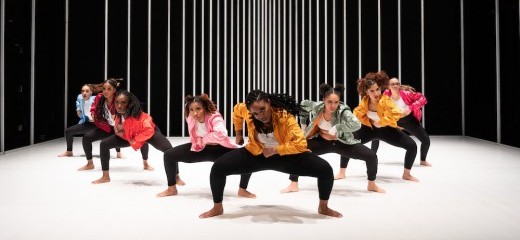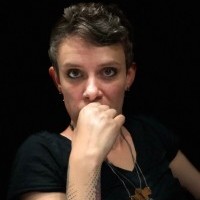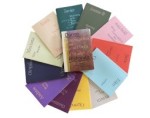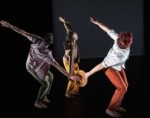
The Politics of Our Comfort
by Emilee Lord
Sometimes, work calls us to remember just how human we are, not because of any grand feats or heroic acts, but because of the quiet and desperate nature of being us at times. In Oona Doherty’s Hard to be Soft - a Belfast Prayer, we are witness to those that are covered painfully by the armor of having to continue no matter what. The tenderness in this piece is solitary. It is meant to be seen in whispers under the tough exterior of generations of strife and resiliency. Toughness is a uniform. I come from a hard place where resilience is not rewarded by hope and success, where you simply do what you must. I felt exonerated by her work; asked to forgive, to laugh, and to tell the truth.
The set design, by Ciaran Bagnall, consisted of a wall of vertical bars across both downstage and up. The front section was opened and closed throughout the piece, redescribing the space. At the start, three figures walked out and placed a broken and smoking Censer on the floor. They stood over it in an aspect of either prayer or mourning. After this prayer faded - this broken hope of a prayer and nod to the religious history of Belfast - the lights came up on Oona Doherty lying where the object was.
The sound design by David Holmes had a liturgical quality interspersed with the words of men and women; incantations and strings, fights and hollers mingling with prayer and worship. This functioned to reference the Christianity of a place and to reframe reverence and worship overall.
Doherty moves through a stretch and grace pulsated by the mimicry of spoken sound bites. She reaches through long extensions of the arms and counterbalances, shimmering this movement with flicks of energy in the hands and feet, slowly pulling detail into her face. With a calm and gentle strength, she melts in and out of characters - hardened young men and women, back and forth, fighting, swaggering, morphing into religious iconography, extending all of this and the people she is honoring as an invocation.
Enter Doherty’s Sugar Army. The Sugar Army, a troupe of 10 teenage girls, is a section of Hard to Be Soft that recruits from schools wherever the piece is being performed. It is an ensemble unison that has been compared to the Maori Haka. The movement stomps and circles, flecked with sass, authority, and celebration. Before they enter, a female voice comes in over fading music and speaks of “making light of tragedy” and performing the bravado of a place. For the Sugar Army to come out after this blatant clip made their assertion of themselves and their power all the more poignant.
The third section of the piece is a duet between John Scott and Sam Finnegan, who represent two generations of men. The men were big working-class looking fellows, with intense energy, the kind of energy that marks a blue-collar man with a sense of right and wrong, that makes a man fight his brother yet protect his kin. Mining the machismo of a multigenerational experience with Belfast, the duet embraced masculinity, it’s rage and endurance, and it’s capacity for fallen, broken moments. Aspects of struggle and exhaustion were visible in the bodies with grappling embraces and Sumo like wrestling. Spots of quick tenderness emerge from a reassuring hand on a shoulder or reaching as in a handshake only to hold, counterbalance, and turn. Projected above and behind the men was a video designed by Jack Phelan. It was a prismatic depiction of two men in a fractured arrangement of images and flickering colors.
The final section, a solo by Doherty, had the same constant and bewildering stutter and shift between characters' physicality, religious images, and contemporary dance. A laugh becomes a cry becomes a cry out becomes a challenge becomes a baby in her arms becomes a reach for help on high. It’s a kaleidoscope of physical authority and authentic, albeit fragmented, storytelling. And it felt humbling to watch as it let you into the power of bodies and the physicality of people from hard places performing their own safety or prowess. It’s all posturing and bellowing and facades. The soft underbelly is only visible in the details of a face, the shake of a hand, or a quiet reach towards the heart. Isn’t this close to life?
We are always our truth, and there is nowhere to put that down. It is possible to live. It’s possible to fight and embrace at the same time. As one of the voiceovers summed it up: “It's the politics of our comfort...We are superstars in stagnancy for putting on our armor and getting on with the day. If you’re in a shit hole but you look fucking amazing, that’s um… empowering.”
Oona Doherty's spoken piece at the end sounds off across an empty space with lights fading into a single line against the back structure “...passion and rage and beast and angel and nothing. All at the same time, nothing.” You witness this heavy nothing in her hands.
Hard To Be Soft - A Belfast Prayer, Oona Doherty, Irish Arts Center, NY, January 13 - 23
By Emilee Lord
January 27, 2022









